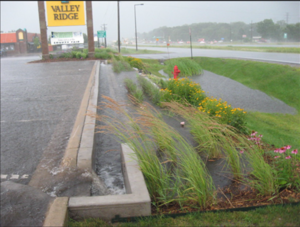
Assessing the performance of wet swale (wetland channel)
Swales retain solids and associated pollutants by settling and filtering. A typical method for assessing the performance of of BMPs with underdrains is therefore measuring and comparing pollutant concentrations at the influent and effluent. If the swale is designed for infiltration, see Assessing the performance of bioretention.
An online manual for assessing BMP treatment performance was developed in 2010 by Andrew Erickson, Peter Weiss, and John Gulliver from the University of Minnesota and St. Anthony Falls Hydraulic Laboratory. The manual advises on a four-level process to assess the performance of a Best Management Practice.
- Level 1: Visual Inspection. This includes assessments for infiltration practices and for filtration practices. The website includes links to a downloadable checklist.
- Level 2: Capacity Testing. Level 2 testing can be applied to both infiltration and filtration practices.
- Level 3: Synthetic Runoff Testing for infiltration and filtration practices. Synthetic runoff test results can be used to develop an accurate characterization of pollutant retention or removal, but can be limited by the need for an available water volume and discharge.
- Level 4: Monitoring for infiltration or filtration practices
Level 1 activities do not produce numerical performance data that could be used to obtain a stormwater management credit (stormwater credit). BMP owners and operators who are interested in using data obtained from Levels 2 and 3 should consult with the MPCA or other regulatory agency to determine if the results are appropriate for credit calculations. Level 4, monitoring, is the method most frequently used for assessment of the performance of a BMP.
The adjacent table summarizes the four levels of assessment.
Levels of assessment for stormwater best management practices (stormwater control measures)
Link to this table
| Level | Title | Objectives | Relative | Typical elapsed time | Advantages | Disadvantages |
|---|---|---|---|---|---|---|
| 1 | Visual Inspection | Determine if stormwater BMP is malfunctioning | 1 | 1 day | Quick, inexpensive | Limited knowledge gained |
| 2 | Capacity testing | Determine infiltration or sedimentation capacity and rates | 10 | 1 week | Less expensive, no equipment left in field | Limited to infiltration and sedimentation capacity/rates, uncertainties can be substantial |
| 3 | Simulated runoff testing | Determine infiltration rates, capacity, and pollutant removal performance | 10-100 | 1 week to 1 month | Controlled experiments, more accurate with fewer tests required for statistical significance as compared to monitoring, no equipment left in field | Cannot be used without sufficient water supply, limited scope |
| 4 | Monitoring | Determine infiltration rates, capacity, and pollutant removal performance | 400 | 14 months | Most comprehensive. Assess stormwater BMP within watershed without modeling | Uncertainty in results due to lack of control and number of variables, equipment left in field |
Use these links to obtain detailed information on the following topics related to BMP performance monitoring:
- Developing an Assessment Program
- Water Budget Measurement
- Sampling Methods
- Analysis of Water and Soils
- Data Analysis for Monitoring
Related pages
- Terminology for swales
- Overview for wet swale (wetland channel)
- Types of filtration
- Design criteria for wet swale (wetland channel)
- Construction specifications for wet swale (wetland channel)
- Operation and maintenance of wet swale (wetland channel)
- Assessing the performance of wet swale (wetland channel)
- Plants for swales
- Check dams for stormwater swales
- Calculating credits for wet swale (wetland channel)
- Cost considerations
- External resources for wet swale (wetland channel)
- References for wet swale (wetland channel)
- Requirements, recommendations and information for using wet swale in the MIDS calculator
- Requirements, recommendations and information for using swale side slope as a BMP in the MIDS calculator
This page was last edited on 23 November 2022, at 22:21.


